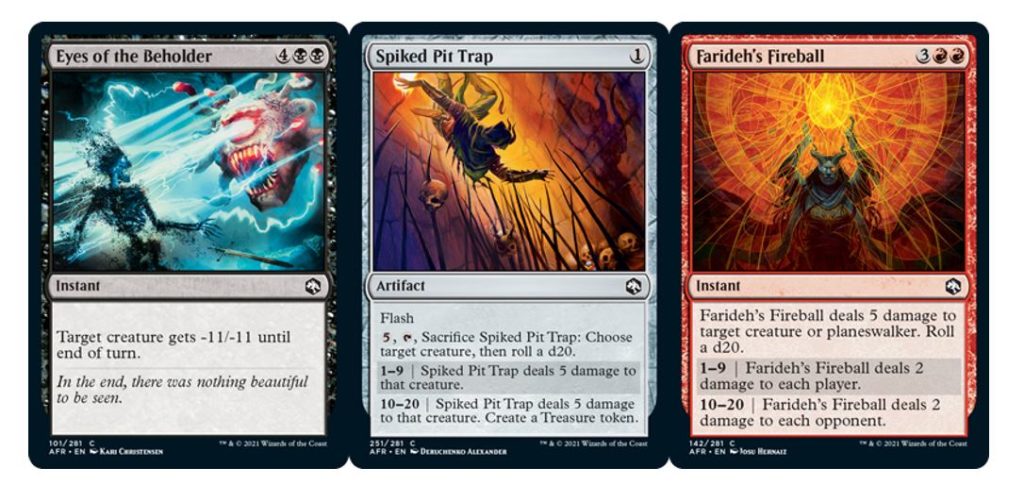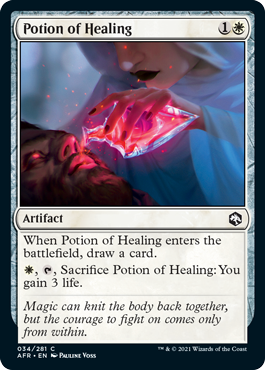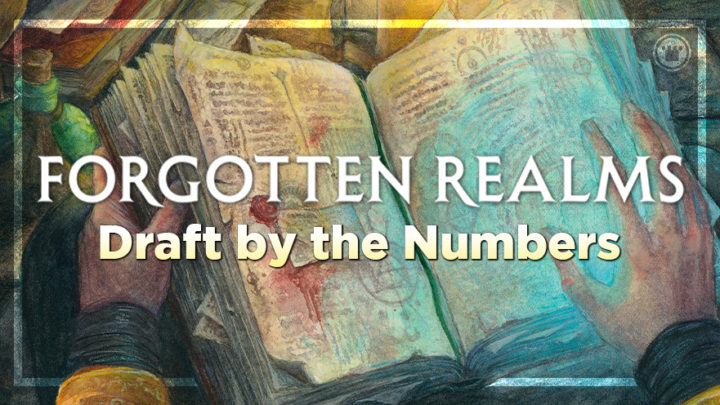Well, we are now two weeks deep into our Adventures in the Forgotten Realms dungeon crawl. Hopefully you’ve all had the chance to experience its traps and tribulations for yourselves, assisted by our trusty Draft Guide!
But the thing about putting out Draft strategies in the opening week of a new set is that inevitably, there are deeper insights into the format which are left unsaid. Flashy set mechanics and signpost uncommons help us get our bearings, and timeless Limited maxims like B.R.E.A.D. can inform our surface-level card evaluations. But no card is played in a vacuum. To master a Draft format means feeling out the common interactions and play patterns of that set until you know which cards drive your win percentage and why.
In this week’s coda to the AFR Draft Guide, I’ll be sharing some of those crunchier, more theoretical understandings — and showing my logic, so you can draw your own conclusions on this unique set.
NOT ALL STATLINES ARE CREATED EQUAL
The current topic of interest among more competitive and analytical drafters is the dominance of base-red aggro in AFR. Thanks to the advent of stat-gathering sites like 17lands.com, which compile details from tens of thousands of MTGA drafts, we can see that “Mono-Red + Splash” is the most successful color composition across all AFR decks, with other aggressive red combinations close behind.
Why is aggro so consistent in a format without good one-drops or direct damage, where the set mechanics let any deck generate bonus life, mana and chump blockers?
It starts with this specific set of two-drops, prized for their ability to immediately punch through three-toughness blockers (Gnoll Hunter needs a bit more help to get going, but it’s reliable enough). Killing three-toughness creatures is very important – every color has a common two-mana 1/3 with upside, and three is the most common toughness across the whole set. When you consider that red also has Valor Singer, a common three-drop which will boost even their lesser attackers over this threshold, we can appreciate how these beatdown decks get off to a rolling start.
But the bigger thing to understand here is how difficult it can be to find good blocks in AFR. Looking at the commons and uncommons, there are only nine creatures below mana value five which can survive combat with these two-drops! Most of them are uncommon, meaning they won’t feature in a lot of drafts, and the three cheapest to cast are 0/4’s, meaning the aggro player can safely “chump attack” with 3/1’s to threaten combat tricks or push through smaller attackers.
As we can see, Circle of the Moon Druid is the ONLY common three-drop which reliably keeps 3/1 attackers out of the red zone. This makes the Druid, as well as Veteran Dungeoneer in white, your most reliable tools to stem the bleeding early on. 17Lands shows that decks which include the Dungeoneer have a 4.8% higher win rate in games when they draw it. That would make it one of the most impactful commons of the set, and white’s fifth-best card overall ahead of rares like Paladin Class and Dancing Sword! Of course, I wouldn’t recommend using this highly-abstracted rating as an absolute pick order, but it is a good reminder of how well this sort of subtle, context-specific card does its job.
These lopsided stat distributions start to build a more practical framework for evaluating creatures in AFR Limited. For most of the game, creatures will need at least three power to be threatening on attack and at least four toughness to be an advantageous blocker. Anything smaller will likely be relegated to the role of utility piece and/or chump blocker.
As we go up the curve, we encounter five power/toughness as the second key threshold for combat. Of the 26 non-rare creatures which can safely block a 3/x, only three of the most expensive can also block a 5/x. I like to think of these as weight divisions for combat, and how your deck’s creatures are distributed across them dictates much of your role in a match-up.
THE BEST DEFENSE IS A LOW EXPENSE
The reason we need to spend so much time theorycrafting how creatures trade in combat is that most removal in AFR is significantly more expensive than we’re used to. Outside of Power Word Kill, Burning Hands and Dragon’s Fire, you can’t rely on cutting down an attacker before it hits you; and as soon as you fall a step behind in answering opposing creatures, you’ll be bleeding three to six life per turn! Still, you need some way to pick off opposing big stuff and flyers. When you can’t get the good uncommon removal, there will be pressure to jump on the expensive-yet-reliable options like Eyes of the Beholder, Spiked Pit Trap, and Farideh’s Fireball.

But the stats and more general Magic math agree you should try and show restraint when it comes to these pricey kill spells. Since in many cases a two-drop attacker will be just as hard to block as a four-drop, you will often be forced to overspend on these big spells to take relatively tiny threats off the table. And that’s in a good scenario, since even with the usual 17 lands in your deck, you have at best coin flip odds of reaching five or six lands on curve (let alone seven for the mighty Black Dragon). The aggro decks are just too fast to allow this sort of delay, and all three of these costly answers have negative impact ratings on 17Lands as a result. In practice, I think the first one of these you play is reasonable to top off a “removal curve” of better spells, but it’s not worth flooding your deck with lands or throwing away valuable Treasure to justify any extra copies.
ARE DUNGEONS A TRAP?
One of the most difficult parts of this set to evaluate during preview season was the marquee mechanic: dungeons! Magic has never seen anything quite like this external scoring track before, and with most of the triggered abilities providing only marginal advantage, the merit of intentionally prioritizing venture cards in your draft relies on your ability to reach the final floor. Whether you’re unlocking the high-impact effects from Tomb of Annihilation or Dungeon of the Mad Mage, or switching on bombs like Nadaar, getting 4-7 venture triggers is going to be a make-or-break for dungeon-focused Draft decks.
The issue for those picking up multiple Cloister Gargoyles early is that you need quite a lot of venture spells to reliably achieve this. If we assume we get roughly a single trigger out of each spell with venture, then we can use the handy multivariate hypergeometric deck-u-lator to figure out roughly how long it will take us to draw enough and complete our first dungeon.
Trophy-getting White-Black decks playing Barrowin of Clan Undurr seem to have 7-9 venture spells on average. With seven hits, our odds of seeing four of them in our top 14 cards is 17.8% — even with nine hits, it’s only 38.3%!
Of course, the venture spells and dungeon floors themselves at least generate a little value, but for the archetypal payoff cards like Barrowin and Gargoyle, it’s a bad look. This implies we need to lean on recurring triggers — not single triggers — wherever possible for these cards to work out. Even for a blue control deck trying to get through Labyrinth (which is seven triggers), your odds of finding 7/9 venture spells in the top half of your deck is less than 9%. So, succeeding with the Esper Dungeons theme requires not just drafting the payoff cards, but also looking for the best reusable venture effects, and crafting a deck which enables those cards to get through multiple dungeon floors quickly – such as pairing Delver’s Torch with Blue-White’s handful of cheap fliers.
STATS CAN HELP YOU GET AHEAD IN LIFE
There are not a lot of successful White-Black decks in the higher ranks of Draft to generate the stats we need to vindicate our reasoning. But we can also apply it to a very prominent trigger-happy deck: White-Green Lifegain! Comparing the impact ratings for lifegain cards in this deck vs. their impact in other archetypes shows which ones are the best enablers in this deck, and the results back up our understanding of the set as a whole. Prosperous Innkeeper, already the second-most impactful uncommon in AFR, shoots up above even in-color rare creatures!
Steadfast Paladin and Froghemoth are also more valuable in this deck, but Sylvan Shepherd’s rating falls off somewhat. It’s not hard to relate this back to the critical interactions between two- and three-mana creatures; Shepherd is a 2/3 for three, which has to be able to attack to generate a trigger, while Steadfast Paladin attacks a turn earlier, and can also gain life from blocking or green’s “punching” removal.
Despite the “more is more” incentives of Celestial Unicorn, Trelasarra, Moon Dancer and Cleric Class, adding single-instance lifegain cards doesn’t really help this archetype. Dawnbringer Cleric, Inspiring Bard and even Potion of Healing lose impact relative to their performance in non-GW decks. Only Priest of Ancient Lore, Rally Maneuver and Hill Giant Herdgorger seem worth including alongside the powerful recurring lifegain engines.
Again, our understanding of the common attack/block scenarios in AFR explains why these specific cards help the archetype. Compared to the others, they offer reasonable ways to block (and not with your vital Innkeepers or Unicorns!), so you can survive against the 3/1 onslaught!
LET THE DATA BE YOUR MUSE
MTG Arena and a wealth of powerful online tools allow Magic players to analyze formats and play patterns like never before. The inherent variance of the game has always made it difficult to draw empirical conclusions from personal play experience, since the sample size will always be small. Working with huge data sets can broaden our understanding of our decks, and what biases might exist within our own process for building them. It will almost certainly help you become a better player.
That being said, I should reiterate that statistics — especially any single stat bereft of context — are at best an invitation to explore new lines of reasoning. If you see a stat that totally goes against what you think of a card, you’re not necessarily wrong. Should you be snap-picking Potion of Healing over most uncommons in white just because its Impact-When-Drawn rating is higher across all archetypes? Or is it more likely that the card is extremely narrow, and due to that narrowness, it only sees play in decks where it is specifically great, artificially inflating its win rate?

I’ve grown to enjoy these little “explain the stat” puzzles, along with the other benefits of combing over Magic’s numbers. I hope the math works out for you as well.

Tom’s fate was sealed in 7th grade when his friend lent him a pile of commons to play Magic. He quickly picked up Boros and Orzhov decks in Ravnica block and has remained a staunch white magician ever since. A fan of all Constructed formats, he enjoys studying the history of the tournament meta. He specializes in midrange decks, especially Death & Taxes and Martyr Proc. One day, he swears he will win an MCQ with Evershrike. Ask him how at @AWanderingBard, or watch him stream Magic at twitch.tv/TheWanderingBard.

